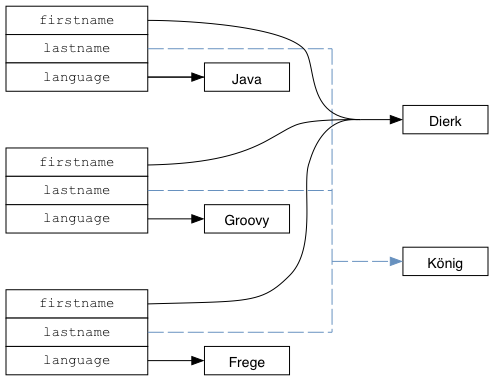data Person = Person { firstname, lastname, language :: String }
javaDierk = Person "Dierk" "König" "Java"Efficient Immutables
A cornerstone of functional programming is to work almost exclusively on values.
Values never change. 42 is 42 and when you apply the function
(+1) to it, then it will return 43 but 42 remains to be 42.
Values are immutable.
This is quite obvious for the case of numbers. But how about Strings? Most popular languages treat them as immutable values. This has the benefit that we can safely pass them around without worries that some other code may change their content.
Frege extends the benefits of immutability to all pure* data structures, including lists, maps and other standard data structures as well your self-made ones!
(*) Pure means that the data structure doesn’t announce any state change or other side effect in its type.
This may sound totally unpractical when you come from an object-oriented background and you may ask if that doesn’t lead to extensive copying and memory exhaustion. It turns out that when consequently programming with values there is only a surprisingly small price to pay for a huge number of benefits.
Custom Data Structures
Let’s start with common, simple data structure: a Person that has a first name, a last name, and
thinks in a certain programming language.
When we create the javaDierk value of that Person type it is automatically immutable!
There are actually two separate features of the language that we see here:
-
Frege has no assignments, so the
=sign above denotes a definition not an assignment. In particular, we cannot redefinejavaDierkto point to some other person. Whoever referencesjavaDierkwill once and forever see the "thinking in Java" version of me. -
We cannot change the person value itself. But we can create new value, based on the given one.
groovyDierk = javaDierk.{ language = "Groovy" }
fregeDierk = javaDierk.{ language = "Frege" }|
Note
|
There are many interesting ways to work with the record syntax that we will cover in a future post. |
For now, we have three distinct Person values. With every change we get a
new copy. What looked like "setters" works actually more like a copy constructor.
But even though we have three copies, there is some automatic structural sharing going on as depicted in the following figure:

Since we are consequently working with values, we can always safely share not only String values as in the example above but every value. Note that this property could not be achieved if we would allow any kind of mutability to silently creep in.
But what if I have a really big data structure and make a real lot of changes to it?
Well, let’s try. Assume we have a value of the data structure D with a field x that contains
a million Strings (maybe subject to lazy evaluation).
Then we update a second field y a million times. This will produce a million copies
and we are crazy enough to hold on to each and every copy to prevent early garbage collection.
Even this crazy scenario only produces the tiny rightmost blue hump in memory consumption that you see in the magnifier glass below.

Note that the list of Strings is just as immutable as a single String and can thus be safely shared
between all copies of D.
It goes without saying that immutable data structures can not only be shared safely between API providers and consumers in a single-threaded scenario but also between concurrent and massively parallel computations.
The small price we pay is a little bit of temporary memory and some extra time for garbage collection.
|
Important
|
Immutable by default
The best of all: we did not write a single character to make all that work!We did not invest a single brain cycle. It is all automatic. |
More Considerations
Deeply nested data structures are notoriously expensive to copy and to compare. Immutable data structures can often alleviate that burden by just copying or comparing one single reference. A good example is what we called the "copy constructor". Beside setting the provided value(s), it just copies the top-level references and, yet, it is a deep copy anyway.
All standard data structures in Frege are immutable. This must be surprising if you come from the OO world. We are so used that e.g. a map changes its content all the time. We may even consider that to be a map’s main purpose in life! Now is the time to reconsider that world view. In the references you will find information and inspiration about that topic.
Now what is dierk’s current language that he thinks in? Which of the three references do we use?
Wouldn’t it be better to keep just one reference around that points to "the latest"
Person? We will cover this scenario in a future post where we will also experience the
Frege "mechanics" that prevent such mutable state from undermining our immutable data structures.
References
| Chris Okasaki |
"Purely Functional Data Structures" |
| Rich Hickey |
Keynote: The Value of Values |